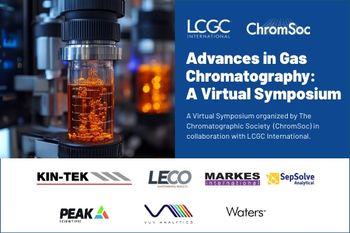
- LCGC North America-03-01-2020
- Volume 38
- Issue 3
Sample Preparation in the Rearview Mirror: Looking Back on 2019

This selection of influential recent papers on chromatographic sample preparation gives us a sense of important developments.
This month’s installment of “Sample Prep Perspectives” is the first of two looking the state of sample preparation in 2019; in May, we present our annual review of new product introductions in the past year. For this month’s column, we asked several thought leaders in the field their opinion on the most influential journal articles on chromatographic sample preparation. The results present a forecast of emerging technologies that may impact the future of the field.
During the week before the new year, electronic and print media are inundated with lists of the top happenings in the previous twelve months. In that spirit, I reached out to several thought leaders in the field (see Table I) to discuss what they believed to be the most influential paper in the area of chromatographic sample preparation published in 2019, with a brief description of why, in their opinion, the article was impactful. The results cover a variety of applications and reviews of emerging techniques that may soon become more common in the sample preparation arsenal. Other than the common theme of chromatographic sample preparation, the only unifying theme was the comments on the difficulty of this task.
Electromembrane Extraction
Norwegian researcher Stig Pedersen-Bjergaard is arguably the leading proponent of electromembrane extraction (EME), and selected an article in this area (1). He notes that EME, or electrophoresis across an oil membrane, is becoming of increasing importance. Publication of new manuscripts is vital to understand where the EME principle fits relative to existing approaches. The unique feature presented in this article is the use of three-dimensional (3D) printing for fabrication of the EME device. This device included a conductive polylactic acid filament, and accommodated a 1 mL sample with anion migration through the 3D printed porous material to the acceptor solution (see Figure 1). The inner, concentric vial contains the acceptor solution. Combined with capillary electrophoresis, submillimolar detection limits were obtained from the anions of strong acids. More importantly, a large step forward in the fabrication of EME devices with unique geometries and novel materials was demonstrated.
Vortex-Assisted Liquid–Liquid Microextraction
Another newer approach for the micro-scale isolation of solutes from aqueous solution is vortex-assisted liquid–liquid microextraction (VALLME). Elia Psillakis of the Technical University of Crete proposed, and has spent the last decade developing, the technique. Naturally, the most influential article in this area is one of her reviews, which serves as both a presentation of the fundamental understanding of VALLME and a tutorial on its use (2). Hydrodynamic, interfacial, and mass transfer concepts provide a deeper treatment. VALLME uses vortex agitation to disperse microliters of water-immiscible solvent into an aqueous sample. Following extraction, centrifugation promotes phase separation, and the isolated extracting solvent is ready for analysis. One particular advantage of the use of vortex agitation is that dispersive liquid–liquid microextraction (DLLME) can occur without the use of a disperser solvent. In this review, essential considerations are given thorough treatment, including drop breakup and emulsion formation, mass transfer rates in disperse systems, and emulsion destabilization and mechanisms of phase separation. Psillakis discusses the effects of extracting solvent type, solvent and sample volumes, surfactant type and concentration, pH and ionic strength, and vortex speed and time. Intensification of the phase separation via centrifugation, magnetic stirring, ionic strength adjustment (such as through salting out), and other means to increase drop coalescence are discussed. Though understanding of the principles of emerging analytical techniques, such as presented here for VALLME, is necessary for the transfer of knowledge required for technique development, instrumentation considerations, method development and transfer, and ultimately widespread acceptance.
Metal-Organic Frameworks
Crystalline porous networks made from metal ions or clusters coordinated with organic linkages, known as metal–organic frameworks (MOFs) is the topic of the influential paper recommended by Mihkel Koel of the Tallinn University of Technology (3). MOFs are used in a variety of forms of solid-phase extraction (SPE), including the conventional cartridge and pipet-tip formats, stir-bar sorptive extraction (SBSE) and in dispersive- and magnetic-SPE. Each of these forms of SPE approaches is discussed relative to MOFs, and the green emphasis of MOFs particularly impressed Koel. The thoroughly referenced (105 references) review presents the stability of MOFs in aqueous systems, such as collapse of the MOF due to competitive coordination with water, metal–ligand coordination geometry, surface hydrophobicity, crystallinity, and presence of defects. The hard/soft acid/base (HSAB) principle is used to describe the coordination between organic moieties and metal ligands. The manuscript also discusses the mechanisms of metal ion extractions with MOFs, including ion exchange and Van der Waals, hydrogen bonding, Lewis acid-base, chelation, and coordination electrostatic forces, with Lewis acid-base interactions being the most common. Applications in the extraction of palladium, lead, mercury, copper, cadmium, thorium, uranium, selenium, and multiple elements from aqueous samples with MOFs are presented. Two specific subclasses of MOFs are highlighted. Zinc (II) or cobalt (II) ions with imidazoles, or ZIFs, combine the benefits of zeolites and MOFs, especially for magnetic-SPE. MOF analogs with covalent organic frameworks (COFs) (consisting of H, O, C, N, B, and Si) connected via strong covalent bonds to organic monomers are a novel type of ordered crystalline porous polymers. COFs show low crystal density, high specific surface area, tunable pore size, and good thermal stability for adsorption of trace elements like Cr3+, Mn2+, Co2+, Ni2+, Cd2+, V5+, Cu2+, As3+, Se4+, and Mo6+.
Analytical Reliability
From a more holistic perspective, Koel also suggested a recent paper that developed the concept of “analytical reliability” as important (4). In this manuscript, the need for quality assurance provided by rapid, simple, and direct analytical processes is claimed. Ten limitations to chemical analysis are identified: instrumentation and sensing systems, lack of involvement of analytical chemists in the knowledge generation from their data, publication vs. usefulness in solving analytical problems, lack of true innovation, lack of harmonization between basic and applied studies, importance of the transfer of knowledge and technology, lack of an interdisciplinary context, lack of interest in the social consequence of analytical activities, foundational education in analytical chemistry vs. analytical knowledge building, and a misunderstanding between method validation and performance characterization and fitness for purpose. Using these constraints, an approach to describing reliability (qualitative analysis) and uncertainty (quantitative analysis) is developed, with reliability expressed as a percentage based on bias and uncertainty.
Other Influential Trends
Rather than singling out a specific article, Hian Kee Lee from the National University of Singapore instead mentioned the evolving trends between new and emerging materials and both solid- and liquid-based sample preparation. Specifically, two-dimensional materials and liquids made by mixing and heating solids are of interest; both MOFs and deep eutectic solvents (DES) would be included in this emerging trend. Meanwhile, Kevin Schug from the University of Texas, Arlington presented the scenario related to the desire to track protein biomarker targets for disease diagnosis, prognosis, and treatment effectiveness (5). Current work in our laboratory extends this concept from the human biopharmaceutical industry to livestock reproduction. Borrowing from the approach for small-molecule analysis, Schug calls for commercial development of large-pore-size SPE materials for selective isolation of intact proteins of varying isoelectric points and molecular weights. Immunoaffinity approaches should be avoided because multiple, diverse proteins may be of interest. Such an approach will provide for the top-down (absolute) quantification of multiple intact proteins from biological samples using liquid chromatography with triple quadrupole mass spectrometry (LC–MS/MS).
Separate from journal articles or specific sample preparation methodologies, perhaps as noteworthy is the creation in 2019 of the Task Force on Sample Preparation by the European Chemical Society’s Division of Analytical Chemistry. The Sample Preparation Task Force aims to promote sample preparation through creating networks and clusters, organizing events, engaging technical communication and information exchange, and promoting fundamental studies and cross-disciplinary collaboration. Innovation and entrepreneurship, as well as involvement of early stage researchers, is encouraged. The task force is led by Elia Psillakis (Professor, Technical University of Crete), and includes Manuel Miró (Professor, University of Balearic Islands), Stig Pedersen-Bjergaard (Professor, University of Oslo), Marcela Segundo (Research Leader, REQUIMTE, Portuguese Government Associate Laboratory for Green Chemistry), Charlotta Turner (Professor, University of Lund), Barbara Bojko (Associate Professor, Nicolaus Copernicus University), Ezel Boyaci (Associate Professor, Middle East Technical University of Turkey), with Janusz Pawliszyn (Professor, University of Waterloo) and Gangfeng Ouyang (Professor, Sun Yat-sen University) as International Guest Members. The network consists of three working groups: science and fundamentals; automation, innovation and entrepreneurship; and information exchange and networking. An open invitation for membership in these networks is extended to all researchers, European and non-European. More details on the Sample Preparation Task Force and Network are found at their website (see reference [6]). If fully successful, this initiative should drive educational and research efforts in sample preparation for some time to come.
Final Assessments of the State of Sample Preparation in 2019
In addition to the list of the “most influential” articles chosen by thought leaders for this column, the first issue of Analytical Chemistry in 2020 presented a series of three critical reviews (7–9) that also assess the current state of sample preparation in the past year. To focus an annual review on emerging analytical extraction strategies, Hanson and Pedersen-Bjergaard centered their article on new liquid and solid extraction phases and on microextraction systems. Specifically, they address liquid extraction phases (including ionic liquids, DES, and nanostructured supramolecular solvents), solid extraction phases (including molecularly imprinted polymers [MIPs] and MOFs), liquid-phase microextraction, solid-phase microextraction, SBSE, micro-solid-phase extraction and microextraction by packed sorbent, and dispersive SPE. Regarding liquid phases, important features included improved environmental sustainability, reduced toxicity, enhanced extraction of polar analytes from aqueous samples, high selectivity, and improved compatibility with analytical instrumentation. Research efforts toward solid extraction phases include increased mass transfer and extraction capacity, increased selectivity or specificity, improved chemical and thermal stability, compatibility with complex samples, improved environmental sustainability, and lower cost. An annual review (8) of sample preparation using MIPs presented choice of reagents including from a green approach; MIPs synthesis for proteins; use of MIPS in SPE (33% of extraction methods published in 2018–2019), dispersive SPE (51%), SPME (5%), SBSE (3%), and with membranes or plates (8%). Applications of extractions with MIPs were categorized in compound classes of natural products (30% of 2018–2019 publications), drugs (27%), emerging contaminants (21%), proteins (12%), and pesticides (10%). The authors suggest that recent results with protein isolation will lead in the near future to an alternative to the use of antibodies in clinical analysis. Might MIPs address the top-down protein biomarker quantification concerns in the previously discussed blog (5) by Schug?
The final of the three critical reviews (9) discusses progress in fast sample preparation techniques, including extraction acceleration by energy exchange (including acoustic waves, microwave, electric field, and multiple fields), materials (such as phase adsorption and partitioning, chemical transformation, size recognition, and mass transfer acceleration), size reduction, and increased throughput.
Conclusions
Although the identification of influential sample preparation articles in 2019 was performed by a select few, the ideas presented may present techniques and approaches that will drive the future of the field. It is interesting that, with the exception of the critical review on fast sample preparation (9), techniques applied to the extraction of environmental solids, foods, and related solid or semi-solid matrices were not discussed. Perhaps this was an artifact of the selection of thought leaders who contributed their ideas, or perhaps research and technology pertaining to these application areas has stagnated. EME, VALLME, MOFs, and other subject matter presented, including expected outcomes from the European Task Force on Sample Preparation, are worth keeping an eye on and represent potential topic areas for upcoming installments of “Sample Prep Perspectives.”
References
- M.L. Tan, M. Zhang, F. Li, F. Maya, and M.C. Breadmore, J. Chromatogr. A1595, 215–220 (2019).
- E. Psillakis, TrAC Trends Anal. Chem. 113, 332–339 (2019).
- N. Manousi, D.A. Giannakoudakis, E. Rosenberg, and G.A. Zachariadis, Molecules24, 4605 (2019).
- M.L. Soriano, M. Zougagh, A. Rios, and M. Valcarcel, TrAC Trend Anal. Chem.114, 98–107 (2019).
http://www.chromatographyonline.com/lcgc-blog-commercial-sample-preparation-materials-isolation-intact-proteins-biological-samples-are-a https://www.sampleprep.tuc.gr/en/home/ - F.A. Hanson and S. Pedersen-Bjergaard, Anal. Chem.92, 2–15 (2020).
- V. Pichon, N. Delaunay, and A. Combès, Anal. Chem. 92, 16–33 (2020).
- L. Xia, J. Yang, R. Su, W. Zhou, Y. Zhang, Y. Zhong, S. Huang, Y. Chen and G. Li, Anal. Chem. 92, 34–48 (2020).
“Sample Prep Perspectives” editor Douglas E. Raynie is a Department Head and Associate Professor at South Dakota State University. His research interests include green chemistry, alternative solvents, sample preparation, high-resolution chromatography, and bioprocessing in supercritical fluids. He earned his PhD in 1990 at Brigham Young University under the direction of Milton L. Lee. Raynie is a member of LCGC’s editorial advisory board. Direct correspondence about this column via e-mail to
LCGCedit@mmhgroup.com
Articles in this issue
almost 6 years ago
Vol 38 No 3 LCGC North America March 2020 Regular Issue PDFalmost 6 years ago
Flash Chromatographyalmost 6 years ago
Go With the Flow: Thinking About Carrier Gas Flow in GCalmost 6 years ago
HPLC Diagnostic Skills—Noisy Baselinesalmost 6 years ago
Hydrophilic-Interaction Chromatography: An Updatealmost 6 years ago
The Why, What, and How of CDS Audit Trail ReviewNewsletter
Join the global community of analytical scientists who trust LCGC for insights on the latest techniques, trends, and expert solutions in chromatography.





